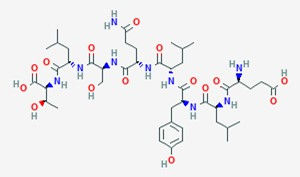Immunonormalizing molecules thymopoietin and levamisole HCl
Inflammation and regulation of inflammatory responses are necessary for life. Dysregulation of inflammatory pathways are fundamental elements of many neurodegenerative diseases. A pleotropic polypeptide hormone, thymopoietin was discovered by its effect on neuromuscular transmission. The clinical similarity of myasthenia gravis (MG) and curare poisoning prompted the search for a curare-like substance in the serum of MG patients. Observing a delayed impairment of neuromuscular transmission in vivo by thymus extracts led to purification of thymopoietin. In MG patients the thymus is postulated to be the main site of autosensitization to the acetylcholine receptor via innate immune system activation giving rise to Toll-like receptor 4- mediated mechanisms contributing to autoimmunity. (Bernasconi 2005)

The active site of thymopoietin is an endogenous ligand for nicotine acetylcholine receptors that are found at post-synaptic neurons and white blood cells. Thymopoietin affects neuromuscular transmission by accelerating the cholinergic-induced inactivation of nicotinic receptors. It also induces the phenotypic differentiation of T precursor cells in vitro (modulating the immune system) while inhibiting phenotypic differentiation of B cells.

A thymopoietin-like product was found only in spleen and lymph nodes. This protein, named splenin, differs from thymopentin (the active pentapeptide of thymopoietin) only by the central amino acid. Synthetic pentapeptides thymopentin and splenopentin reproduce biological activities of thymopoietin and splenin, respectively. Thymosin alpha 1 (Tα1) is a 28-amino acid peptide produced by thymic stromal cells. Prothymosin α is ten times more active than the metabolite Tα1. Thymopoietin, thymopentin, and Tα1 affect neuromuscular transmission. Splenin and splenopentin do not affect neuromuscular transmission and they induce both T- and B-cell precursors.
Research Notes:
1 Synthetic T alpha 1 is marketed as Zadaxin

Thymopentin and Tα1 exert their immunomodulating effect by interacting with Toll-like receptors and intracellular signaling, such as NF-κB, MAPK, and myeloid differentiation response 88 (MyD88) pathways. Immunofan exchanges two amino acids to increase the activity of the synthetic analog. Additionally, thymopentin and Tα1 can counteract a pro-inflammatory cytokine storm and autoimmunity.
Thymopoietin has a brief half-life in serum with long lived effects indicating that the mode of action involves a triggering function of extended cascades in animals. Human circulating thymopoietin levels are high until 40 years old, and then levels decline until 70 years old, when they are undetectable.

A putative thymopoietin mimic, Levamisole HCl, is a synthetic heterocyclic compound that is immunoregulatory. Levamisole HCl shows promise in several diseases that have no satisfactory treatments. It is proposed for treating leishmania, frequently relapsing steroid sensitive nephrotic syndrome, rheumatoid arthritis, multiple sclerosis, and polyneuritis equi. Goldstein (1978) postulated that levamisole forms a thymopoietin-mimetic tertiary structure by its imidazole component.

As shown with thymopoietin, levamisole HCl can normalize a dysregulated immune response by blocking TNFα and IL6. Levamisole is an antioxidant with the effects of signaling cascades far outlasting the serum levels. Levamisole HCl also affects the levamisole-sensitive post-synaptic acetyl-choline receptors.
One study (1983) determined the activity profile of thymopoietin and levamisole overlap, but the mode of action is not the same. Levamisole HCl was marketed in the United States as Ergamisol, the side effects neutropenia and vasculitis were noted in less than 5% of people. In 2012, it was determined that reactive metabolites (present at 16 hours) are related to immune-mediated agranulocytosis. It is noteworthy that an empirical correlation has been made for the occurrence of idiosyncratic drug toxicity and the daily dose. Low daily dose drugs (10 mg or less) are rarely associated with idiosyncratic adverse reactions, regardless of their ability to form reactive metabolites.
Research Notes:
2,3,5 6-tetrahydroimidazole[2,1-b] thiazole scaffold is the structure associated with agranulocytosis. Agranulocytosis is greater in patients carrying the HLA B27 genotype. HLA B27 is a class I surface antigen encoded by the B locus in the major histocompatibility complex (Chromosome 6), involved in the encoding of cell-surface receptors that capture and present self-and pathogen derived peptides to T cells as part of an immune surveillance.

Our goal is to exploit the thymopoietin-like effects of levamisole HCl and avoid the adverse reactions. Over 60 analogs of levamisole HCl have been synthesized, tested in vitro for phosphokinase activity and effects on mitochondria. In vivo assays include effects on Haemonchus larvae and effects in ALS mice models as well as some ALS cell lines. Dogs can show different clinical manifestations of the same immuno-allergic reactions that are observed in people and may serve as a model to test a restructured molecule. Levamisole was successfully synthesized in 2021, levamisole analogs were tested for reactivity in human cells (from a normal subject) and then selected to test for the production of allergic metabolites.


Comments